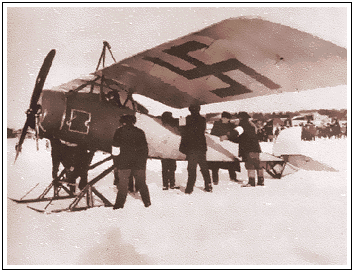


On the side of the whites, action in the air was launched a little later. The first pilots from Sweden were enlisted on 24 February. The aircraft Albatross, brought by them to Finland, arrived in Pietarsaari on the 26 February but had engine trouble. Before it could be fixed, another aeroplane, a Morane-Saulnier Parasol donated by Count Erik von Rosen, arrived in Vaasa on 6 March and was put into action. This plane has the honour of being the first official aeroplane of the Finnish Airforce.
The first five aeroplanes of the whites had been purchased from Sweden. Afterwards there were planes also from Germany and from the Russians. Two DFW C.V planes, for example, arrived on board the Arcturus from Germany on 24 March. They were equipped with two machine guns and bomb hangers. In other words, they were Finland’s first modern war aeroplanes. Shortly after the Russians had closed down the Turku airfield, Captain Georg Herbert, commander of the 2nd Air Brigade, flew a Shetin flying boat to Åland, and was stationed in the voluntary troops of the archipelago acting in that area. In early April, the Finnish arms intermediaries acting in St Petersburg, succeeded in persuading a group of Russian pilots into the service of the whites. These pilots flew one Devjatka flying boat, two Nieuport destroyers and two Nieuport reconnoitering planes to Antrea on the 10th and 11th of April. These planes formed the air detachment of the Karelian army corps.
The Finnish air troops were organized on 10 March, and Captain Hygerth was appointed commander. Von Rosen’s personal emblem, a blue swastika, became the symbol of the flying troops. After the occupation of Tampere the air troops were divided, like the army, into two parts: the western air detachment and the II air detachment of the eastern army, into which the Russian planes and pilots were integrated in the course of time. After the arrival of the German troops in Finland, requests were put forward to Germany, for expertise in the command of the air troops. German Captain Carl Seber was appointed commander of the Finnish air troops on the 28th of April.
Altogether 35 persons, 21 pilots and 14 observers served in the air troops of the whites. Nine of these were of Finnish nationality.
All in all, airborne warfare in Finland was fairly insignificant compared with the thousands of aeroplanes that flew over the fronts of the World War. The German Airforce alone comprised approximately five thousand aeroplanes. But even in Finland, the aeroplanes had a weakening or strengthening effect on the battle morale.

Commander-in-Chief 1918 | Headquarters 1918
| Vaasa Senate | Hannes Ignatius
| Martin Wetzer | Harald Hjalmarson
| Ernst Linder | Gösta Theslöf | Jägers | St Petersburg Question | Relations with Germany | Cross of Liberty
| Eastern Karelia | Uusimaa Dragoon
Regiment | Fir Twig | Finnish Flag
| Swedish Brigade | Civil Guards | Jäger Conflict | Heikki Kekoni | Red Prisoners | Wilhelm Thesleff
| Aarne Sihvo | Rudolf Walden |
Air Force - Air Weapon | Red and White
Terrorism | Great Parade 16 May, 1918 | Åland Question | Monarchy | Mannerheim's Resignation
COURSE OF LIFE | FAMILY | TIME OF GROWTH | MILITARY CAREER | WAR OF INDEPENDENCE | REGENT 1918-1919 | CIVILIAN | DEFENCE COUNCIL | COMMANDER-IN-CHIEF 1939-1946 | PRESIDENT OF THE REPUBLIC 1944-1946 | RETIREMENT | SPECIAL TOPICS | SEARCH